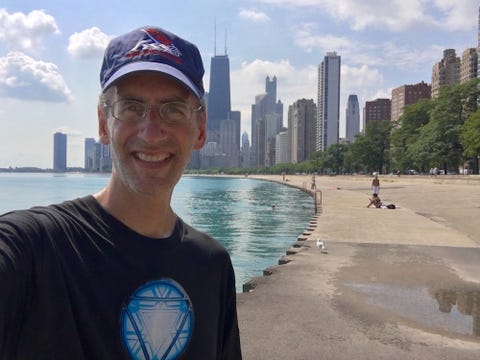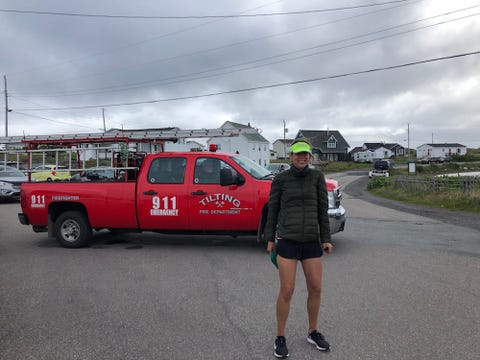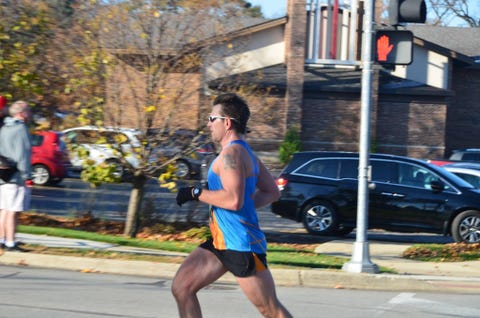The stories make headlines and strike fear in the hearts of runners who read them. Athletes—often young and seemingly healthy—die suddenly at races, during training runs, or in the off hours between them.
Often, the cause is sudden cardiac arrest, which occurs when the heart stops beating. It’s a short-circuit in the electrical impulses that govern your heartbeat. That’s different from a heart attack, typically caused by a blood clot physically blocking blood flow through an artery, though the two can be linked.
According to the latest American Heart Association statistics, sudden cardiac arrest isn’t common among runners—about 0.54 per 100,000 participants in half marathons and marathons experienced it. But it’s often deadly, killing 70 percent of those runners. That’s slightly better than the 90 percent overall mortality rate for people who experience sudden cardiac arrest outside a hospital.
Because so many people don’t live to talk about it, doctors can’t exactly say how often they have symptoms beforehand, said Matthew Martinez, M.D., a cardiologist at the Lehigh Valley Health Network and chair of the American College of Cardiology’s sports and exercise cardiology section. A recent research review published in CMAJ, however, suggests about 29 percent of those who died had some signs.
Those who survived can shed even more light on what occurred in the days and weeks beforehand—as well as what life is like on the other side. Here, five of their stories.

Courtesy of Melissa Ziebell
“I had arm cramps—but doctors didn’t find anything.”
Name: Melissa Ziebell
Age: 38
Location: Pasadena, California
Date of sudden cardiac arrest: March 8, 2015
Ziebell had always been active—so when she moved to France alone for graduate school, the gym was where she made friends. She dabbled in bootcamps, kickboxing, and rollerblading before joining a running club. Before long, she’d completed a 10K, then a half marathon.
She lined up for her second 13.1-mile race, the 2015 Paris Half Marathon, with confidence and an ambitious goal—to finish in 1:45. “I had it on my arm, on my watch, and I was constantly checking that,” she told Runner’s World.
Ziebell was on pace when—just before mile 12—she felt something click. “I remember seeing my legs giving out; I couldn’t move them,” she says. “Then I was falling.”
In the moments that followed, Red Cross volunteers who were attending another runner quickly shifted their attention to her more critical case. They started CPR, then shocked her heart back into rhythm with an automated external defibrillator, or AED. Later, she’d learn she was out for nearly two minutes.
The next thing she remembers, people were calling to her in English and in French. They asked the standard questions—what day it was, her name, where she was. Her answer? Not Paris, but “at kilometer 19.”
Confused and with her goal still in mind, she tried to get up and keep running. Medical personnel took her to the hospital instead. There, rounds of tests revealed a congenital defect in her heart—a tangled formation of her right coronary artery. She had it repaired with open-heart surgery in April, then stayed in the hospital until August, including some time in a cardiac recovery unit.
Such congenital defects are the most common cause of sudden cardiac death in young people, Martinez said. Meanwhile, if you’re older, you’re more likely to have the typical heart-related risk factors—think high cholesterol and high blood pressure—that can lead to heart attacks and sudden cardiac arrest.
Running might help keep those in check, but runners aren’t immune to them, he said. In some cases, no explanation for sudden cardiac arrest is found.
Throughout her life, Ziebell said, she’s had arm pain that flared up with intense exercise. She’d had it checked out before; doctors could never find a specific cause.
Arm pain, especially on both sides, could certainly be a sign of impending heart troubles, Martinez said. Other red flags to watch for include chest pain or tightness, passing out during exercise, or breathlessness that’s out of proportion to the pace you’re running. They’re most concerning when they’re new or different from what you usually experience, he said.
Ziebell hadn’t had any new symptoms in the days and weeks before her incident. In fact, she’d even gone to see a cardiologist a few months beforehand to get a medical clearance signed, which French races required. Some of the conditions that can trigger a sudden cardiac arrest “are hard to find,” Martinez said; communicating with your doctor about any changes in symptoms can help pinpoint them.
Despite the delay in detecting her issue, Ziebell views herself as extremely fortunate. “It’s incredible to look at all the documents that say, sudden death,” she said. “I really died; my heart stopped.” Fortunately, she has no lingering heart or brain damage as a result.
By October, Ziebell was back at the gym; she tried easy running again in January. She sees a cardiologist every three months, and has since finished a 10K at an easy pace. She won’t let fear hold her back: “My heart is not really sick. It was just this physiological issue with the artery,” she said. “I’m not really a scared person.”
In fact, she soon wants to ramp up her training again. Now, she has a new goal: to go back to Paris on the five-year anniversary of her sudden cardiac arrest to run the half marathon again—and this time, make it all the way to the finish.

Courtesy of Marc Rosen
“I thought maybe I was low on electrolytes.”
Name: Marc Rosen
Age: 57
Location: Chicago
Date of sudden cardiac arrest: August 9, 2016
Several times a week, Rosen would run-commute the 6 to 8 miles from his downtown office to his home on the north side of the city. It was an easy way to fit in more miles while training for the Chicago Marathon, a distance he’d completed more than 40 times before.
After exactly 19 minutes and 20 seconds on August 9, 2016—he knows, precisely, thanks to his Garmin data—he stopped for water near Ohio Street Beach, then fell down.
A nurse who was training for the Chicago Triathlon saw him and started CPR. Soon, some lifeguards joined her. One rode a bike to a nearby Chicago Park District facility to retrieve an AED. An ambulance then took him to the emergency room at Northwestern Memorial Hospital, just a few blocks away.
Rosen doesn’t recall any of it. But he does remember this: For about six weeks prior to the incident, there were times where if he stopped for water a couple miles into a run, he’d feel a little dizzy. He’d mentioned it to his wife and some of his running partners.
“In retrospect, maybe it sounds like yeah, that was obvious,” he said. “But at the time you’re thinking, ‘Maybe I didn’t hydrate enough, or maybe I’m low on electrolytes or something.’”
It’s common for runners to ignore or downplay symptoms, Martinez said. Subtle, vague signs might not seem like a big deal at first. Athletes might also fear being sidelined from running. He recommends having a regular primary care physician who knows your running and health history, so you can easily call or book a quick visit to ask about new signs.
After the incident, doctors told Rosen he’d had ventricular fibrillation—a dangerous quivering of the lower chambers of the heart that is the most frequent cause of sudden cardiac death—though they couldn’t explain why.
Five days later, on Saturday, he went home with an implantable cardioverter-defibrillator (ICD) and a prescription for beta blockers, which reduce blood pressure by blocking the effects of adrenaline.
By the following Tuesday, he was cleared to exercise. On September 11, he ran 14 miles with his friends. And on September 25, he ran the Berlin Marathon, finishing more slowly than his personal best, but grateful he was able to run it at all.
Not everything has been easy since. The medications keep his heart rate low, making running feel more difficult. His ICD went off once on a run the following January, which felt “like you’re a marionette and they cut the strings midstride and you just slam into a brick wall,” he said.
Further testing still didn’t pinpoint a precise cause. So, Rosen continues to run, with a close eye on his heart rate. In total, he’s run five marathons since; this year, he volunteered at the Chicago Marathon finish line instead of running not due to his heart, but because of a knee injury.
“There are always going to be risks in life, but it doesn’t seem to be an unacceptable risk,” he said. After all, running is part of who he is. He also makes it a point to travel more—in July, he went to Argentina to see the eclipse—and holds his family and friends a little bit closer. “If you are lucky enough to still be in the game, make sure you enjoy it fully,” he wrote in a presentation he gave before the Chicago Marathon the following year.

Courtesy of Daphne Hodgins
“After my incident, everyone I knew took CPR classes.”
Name: Daphne Hodgins
Age: 52
Location: Tsawwassen, British Columbia
Date of sudden cardiac arrest: March 16, 2013
Hodgins ran casually through high school, college, and beyond—but it wasn’t until her children were a bit older, in elementary school, that she got a bit more serious and joined a running group in her town of Tsawwassen, about 25 miles south of Vancouver.
There, she found other women who matched her paces and interests. They’d travel together to races. By 2013, she’d done 11 half and 11 full marathons, and was training again for the Vancouver Marathon.
One Saturday morning, she was about four miles into an 18-miler—close to the border between Canada and Washington State—with three of those training partners. Apparently, though she doesn’t recall this herself, she told them she wasn’t feeling well. Soon, she’d dropped to her hands and knees.
One of her friends had been a CPR instructor, and went right to work. In the end, she’d wind up performing CPR for close to 10 minutes. “I’m very lucky to have come through without any health issues or changes to my cognitive or physical abilities,” Hodgins said. Indeed, hands-only CPR can double—or even triple—the chances of survival after sudden cardiac arrest.
Meanwhile, her other training partners went from door to door, looking for someone who was awake and could call 911. None of them were carrying a cell phone.
When the ambulance came, paramedics used an AED to shock her heart back into rhythm, then took her to a nearby hospital. Like Rosen, her case was a mystery. She had no family or personal history of heart troubles. “There was no explanation for what occurred,” Hodgins said. “I was subjected to every possible diagnostic test you could imagine and they found nothing.”
But unlike Rosen, she couldn’t pinpoint any changes in the way she was feeling in the days and weeks beforehand.
She stayed in the hospital a week and received an ICD and a prescription for beta blockers. When she got out, she couldn’t drive for six months, so she biked everywhere, and returned to running during a supervised outpatient heart program at the hospital.
She slowly increased her mileage and ran a half marathon in August with the friend who’d performed CPR. Then, all four of the training partners ran the New York City Marathon together. “We did it cautiously—nobody wanted a repeat incident,” Hodgins said. “But it was really special.”
Every day, she thinks of people in similar situations who weren’t as fortunate. All this inspires her to speak up about her experience. Her advice? “Learn how to do CPR and be aware of other people. If someone does stop, ask them, are you okay?” she said. And: “At least one person should have a phone.”

Courtesy of Ron Tran
“Looking back, my training wasn’t that great.”
Name: Ron Tran
Age: 53
Location: Plano, Texas
Date of sudden cardiac arrest: March 22, 2015
It was a warm day in Dallas when Tran and his family lined up at the Rock ’n’ Roll Half Marathon. He started with his daughter, Michelle, but after three miles was feeling good enough to push ahead of her.
By the time he passed mile 12, he was tired, but determined to finish strong. “I thought, ‘Okay, I’ve got about a mile left, I want to push it,’” he said. Then, without warning, he lost consciousness. “The lights were just turned out.”
Somehow he managed to fall on his knees, not his face. He woke up in an ambulance. Later on, he’d learn that two volunteers from Race Guards—an organization that provides medical volunteers on race courses—saw him collapse and rushed to his aid.
Laura Dowd, a veterinarian and the organization’s medical director, was one of them. Tran was having a seizure when she first reached him, she said. Then he stopped breathing—and within a few seconds, his heart stopped, too. She administered CPR until paramedics arrived.
At the hospital, doctors informed Tran he had a congenital heart defect, a malformation of an artery. They implanted a stent and prescribed him medications to reduce his blood pressure and cholesterol.
Their theory? A bit of plaque may have broken off when he started to push his pace, blocking his malformed artery and leading to an electrical problem that caused his heart to halt.
Tran doesn’t remember any symptoms in the days or weeks beforehand. But looking back, he realized that his training wasn’t as stellar as he’d thought at the time. He’d run two or three days a week, with a long run of up to 9 or 10 miles on the weekend, almost almost pushing the pace.
Proper training is one way athletes can reduce their risk of sudden cardiac arrest, Martinez said. By building up your fitness over time, you minimize the strain on your heart during the race itself. Meanwhile, high temperatures, poor hydration, and inadequate nutrition may increase the danger.
Now, Tran trains more—though usually at an easier effort—in three sports, swimming, biking, and running. He puts in about an hour and a half a day, much more on the weekends, to prepare for Ironman triathlons.
He completed his first one, Ironman Texas, in April, then Ironman Boulder in June, and then two more this fall, Chattanooga and Panama City—and now has his sights on a 50K ultramarathon in Dallas in December. Of course, he clears all this in advance with his cardiologist.
[From training tips, to fueling strategies, to improving the mind-body connection, the Runner’s World 2020 Calendar will help you run your best all year long.]
But perhaps the most meaningful race of all was the one he did just a year after his incident. He went back to run the same race—the Rock ’n’ Roll Half Marathon—with Dowd.
When they neared the end, she pointed out the place where he fell. “I was thinking to myself—I was there last year, I’m picking myself up, I’m going to finish this race,” he said. They paused briefly, then continued to cross the finish line and share a hug.

Courtesy of Jim Wagener
“It was a complete surprise.”
Name: Jim Wagener
Age: 46
Location: Chicago
Date of sudden cardiac arrest: Feburary 4, 2015
Though he’d been running marathons since 2000, Wagener was no stranger to heart problems. In 2008, his doctor noticed a heart murmur and sent him to a cardiologist, who found a bicuspid aortic valve—the most common congenital heart defect.
After a year of monitoring and several more marathons, he had open-heart surgery to replace the valve in 2010.
Still, he was shocked when—in the middle of a training cycle for the Illinois Marathon in Champaign in April—he woke up one morning in an ambulance outside his condo.
At about 4:30 a.m., his wife, a nurse practitioner, heard him making loud noises. She thought he was having a nightmare, but couldn’t wake him. Soon, it became clear he was having a seizure—then he turned blue and stopped breathing. So she called 911 and administered CPR until paramedics arrived.
When Wagener thinks back before his first heart problems, he can recall some issues he’d largely ignored at the time, including night sweats and the occasional sudden spike in his heart rate while running. But the cardiac arrest “came as a complete surprise.”
Wagener stayed in the hospital for four days undergoing a battery of tests. Meanwhile, his wife called his father, to see if there was any family history of sudden cardiac arrest. That’s always good to check, Martinez said—since family history of any heart problems elevates your risk of sudden cardiac arrest.
But there were none, and doctors said his problems were unrelated to his previous heart issues. They prescribed an anti-seizure medicine and implanted a defibrillator.
Wagener couldn’t run for six weeks afterward while the wounds from the surgery healed. But soon afterward, he was able to get back to training. In April, when he was supposed to run a full marathon, he ran a half instead.
But he was able to take on 26.2 two more times—that November in Naperville, Illinois, and again at the Illinois Marathon the following April. That would be his last, he said, though he has run a few half marathons since. “It wasn’t against any medical advice, it was just to give my wife peace of mind,” he said. “She was a little nervous every time I was out there.”
Although the risk of another sudden cardiac arrest is higher after the first one, many runners who have had one return to long distance racing without incident, Martinez said.
An ICD can provide a layer of protection, but doesn’t make you bulletproof. After such a major event, you should discuss with your cardiologist—preferably a sports cardiologist—about your training, goals, expectations, and the settings on your ICD, if you have one.
From: Runner’s World US
Source: Read Full Article
